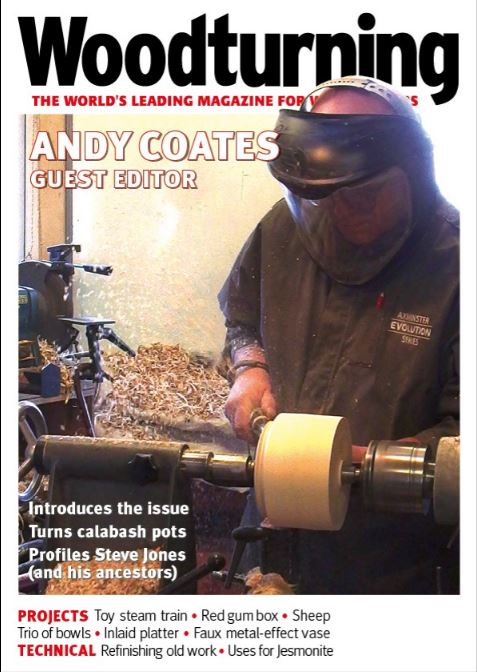
Since about mid 2015 I have written a monthly article for Woodturning Magazine. I had no particular urge to write, but I was urged to write as a favour to the late Editor, Mark Baker. Another author had left and he urgently needed a five page project, and as we were friends, he leant on me a little, “It’s just one article!”. So I wrote a project article for a lightbulb, because I’d made a couple that week, and it was my current *thing*.

Very sadly, Mark died in 2020, and left a huge void in the lives of his family, friends, colleagues, and the small world that is the woodturning community. We used to talk on the phone a lot, and would very often argue about a point of view, a technique, the usefulness of a new product/tool, in fact, we argued about lots of things, but it never got in the way, we were friends. I miss him scolding me for things, cajoling me into writing an article I was less than enthusiastic about, asking for my opinion on something.
I started writing for the magazine as a favour to Mark, but I continued because I (almost always) enjoy the process. I have always written for the novice turner first and foremost, because it is the novice who needs the guidance, the voice over the shoulder, and more advanced readers will simply scan over what they don’t need, and crack on. In truth, many of the more advanced woodturners only need to see a picture of a completed piece, and they can pretty much wing it from there. But writing is worthwhile, helpful, and in some way makes up for the lack of face-to-face interaction that demonstrating provided. It’s 2023 as I write this, and I’m still writing a monthly article, do the occasional Guest Editor slot, and now also do the technical editing that was previously part of Mark’s job.
One of my other passions is books, non-fiction mostly, and when I began woodturning I also began sourcing and buying books on wood turning. I now have quite a lot of books on turning, some going back the 19th c, and have read them all. Many, several times. I also started to take the Woodturning Magazine when I first started turning – oddly enough, from Mark Baker at a woodworking show at Alley Pally in London – but not having the complete set bothered my book-collector brain, and I began searching for old issues. I have every single copy now, including the first five issues that were compiled as a hardbacked book.

I also now have three copies of one book, Woodturning a Foundation Course, by Keith Rowley. I had the first edition, because it was a woodturning book. I then bought the revised edition because it had been revised by Ray Key, a world renowned turner, and one of UK’s biggest names in turning, if not the biggest, and Ray had become a friend when I joined the AWGB committee. And then I have a third edition. And that one is very special to me, because I revised it. I was honoured and flattered to be asked to revise Keith’s fantastic book, and equally honoured to be following Ray Key. Very sadly, Ray died in 2018, and he is still very much missed; he was a giant in our craft, formed the AWGB, drove woodturning in the UK for many, many years, and took it from a quiet occupation practised by a few folk up and down the country, to one that supported International Seminars in the UK.
Writing about woodturning is a great way to focus the mind on the process, the techniques, and the potential problems and issues a novice turner might have. One of the problems that many experienced crafts people have when trying to convey information is familiarity. Once you’ve put you 10,000 hours in to get the point where you can begin to see yourself as an “expert” (this is a whole other article), it’s easy to become blind to precisely what it is that do to achieve a given end. In your personal practice, you probably do things without even thinking about them; you’re probably thinking about other things, where you’ll walk the dog that evening, what you’ll cook for dinner, anything but the task at hand, because your hands know the routine, and just get on with it. Well, writing forces you to fight that separation of brain and hands, and see what you do, and explain it clearly and concisely. And this can also change the way you do things, as familiarity often sets bad habits, that whilst they may work for you, are not the best way to instruct somebody else to work. So, writing is a tool in and of itself.
I have by now written over 200 woodturning articles, projects and technical, dozens of tool and equipment reviews (not all published…”You can’t say that!”, and articles for other woody magazines, and that’s over 2,000 A4 pages, and see no immediate end to doing so. As long as I can think of something to say, I hope they’ll keep allowing me to say it.
So, if you are a woodturner, or even just interested in turned work, please buy the magazine, subscribe (there’s always a good deal), because it not only supports me, but also the craft…click on the link under the following cover shots…



